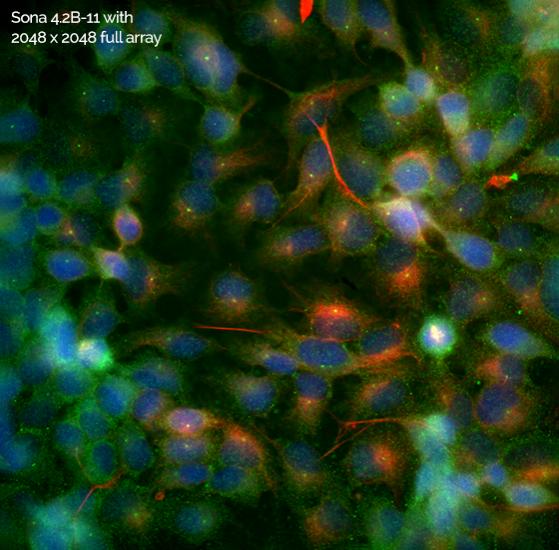Sona는 Andor의 최신 고성능 sCMOS 카메라 시리즈로, 특히 생명 과학 이미징 분야에 특화되어 있습니다.
새로운 Sona 4.2B-6 모델은 감도, 속도, 해상도의 완벽한 균형을 통해 다양한 분야에서 최적의 이미징 성능을 제공합니다.
6.5µm 픽셀을 탑재한 4.2메가픽셀 포맷은 널리 사용되는 40배 및 60배 배율에 이상적입니다.
플래그십 모델인 Sona 4.2B-11은 탁월한 32mm 시야각을 제공하여 감도와 시야각을 모두 만족시키는 최고의 솔루션입니다. 모든 Sona 모델은 95% 양자 효율(QE)을 제공하는 최신 후면 조사형 sCMOS 기술을 탑재했습니다. 두 모델 모두 SRRF-Stream+ 실시간 초고해상도 기술을 지원합니다.
- 95% QE 및 -45 °C 냉각 - 가장 민감한 백라이트 sCMOS 사용 가능
- 6.5µm 및 11µm 픽셀 크기 옵션 - 대부분의 배율 및 응용 분야
에 적합 - 최대 74fps 풀 프레임 - 번짐 없이 동적 프로세스를 따라가기
- > 99.7% 선형성 - 전체 동적 범위에서 뛰어난 정량적 정확도
- 이제 SRRF-Stream+와 함께 사용 가능 - 실시간 초고해상도
Ultimate sCMOS Sensitivity
The NEW Sona camera contains back-illuminated sCMOS sensors with up to 95% QE which, coupled with either 6.5 or 11 µm pixels, means that they are optimized for maximum photon capture, ideal for light starved applications.
-

-
Comparative Signal to Noise under low light conditions (10 incident photons per 100 µm2 sensor area)
- Under identical low light optical conditions, the Sona 4.2B-11 with back-illumination and large pixel size is well suited to maximizing photon capture and Signal to Noise.
Ultimate sCMOS Field of View
The flagship Sona 4.2B-11 back-illuminated cameras utilize a unique technology approach to usefully access the entire 2048 x 2048 array, offering an impressive 32 mm sensor diagonal.
* Perfect for microscopy, capturing the largest possible field of cells with optimal clarity (combined with suitable magnification).
Microscopy Field of View Advantage: Sona 4.2B-11 with 2048 x 2048 array has a 62% larger field of view than a competing back-illuminated sCMOS camera with a 1608 x 1608 array. A 60x objective and additional coupler magnification* is utilized to access the full 2048 x 2048 array, while preserving Nyquist resolving clarity.
*Magnifying Coupler Unit (MCU) available from Andor
For the commonly used 40x and 60x objectives and standard port sizes the new Sona 4.2B-6 with a 2048x2048 array and a smaller 6.5 µm pixel offers a perfect solution. Sona 4.2B-6 provides a stunning combination of sensitivity, speed and resolution to ensure the best performance from your microscope.
sCMOS Solutions for High Speed Imaging
sCMOS technology is based on highly parallel pixel readouts and as such is superbly architected to combine high frame rates and high resolution, while maintaining very low noise.
The Sona and Marana back-illuminated cameras each offer high speed modes. The new Sona 4.2B-6 offers an impressive 74 fps at 16-bit. However, the Zyla modelsremain the ultimate solutions for following high speed processes, while maintaining lowest possible noise and maximum dynamic range
sCMOS Solutions for Extended Dynamic Range
Andor sCMOS cameras each offer an Extended Dynamic Range functionality, supported by a 16-bit data range. Harnessing an innovative ‘dual amplifier’ sensor architecture, we can access the maximum pixel well depth AND the lowest noise simultaneously, ensuring that we can quantify extremely weak and relatively bright signal regions in one snap.
- In biology, this functionality is useful for imaging and quantifying many challenging samples, such as neurons.
- In the physical sciences, high dynamic range capability is central to countless measurement types, such as in astronomical photometry.
* Furthermore, to achieve best in class quantification accuracy, Andor have implemented enhanced on-head intelligence to deliver market-leading linearity of > 99.8%.
Most Sensitive Back-illuminated sCMOS
Sona back-illuminated sCMOS models feature 95% Quantum Efficiency (QE) and market-leading vacuum cooling to -45°C.
The darkcurrent of GPixel sCMOS sensors such as that used in the Sona 4.2B-11 is relatively high, compared to that of BAE/Fairchild Imaging sCMOS sensors that are utilized in Zyla and Neo sCMOS cameras.
This places additional emphasis on the need to deep cool the sensor in order to suppress the noise floor, i.e. minimizing the camera detection limit.
Due to the unique vacuum design, Sona thermoelectrically cools to -25°C with high precision and stability using only the internal fan for heat dissipation.
Furthermore, Sona can utilize liquid assisted cooling to push down to a hugely competitive -45°C!
"Back-illuminated sensors are valued specifically for their enhanced sensitivity – it makes sense to choose the most sensitive adaption of this high-end technology."
Having the most sensitive Back-illuminated sCMOS camera carries a host of practical advantages within fluorescence microscopy:
- Reduced laser illumination intensity - keep cells alive throughout study (i.e. suppressing phototoxic effects) and also limit dye photobleaching
- Reduced fluorophore concentrations - maintaining accurate physiology in living specimens
- Lower exposure times - follow faster processes
- Better SNR with TIRF and confocal low light modalities - better image clarity with techniques that reject out of focus photons.
Anti-Glow: Accessing the Entire Sensor Array
The GSense400 back-illuminated sensor from GPixel is widely recognised to suffer from glow at the edges of the sensor.
This glow manifests as false signal and is exposure dependent.
To date, the effect has forced camera manufacturers to either limit the usable region of the sensor to an array size notably smaller than the native 2048 x 2048 full resolution, or alternatively to impose a severe 30 millisecond restriction on the maximum exposure length that is permitted by the camera.
Either way this fundamentally restricts performance and usefulness across a range of applications, either through field of view limitation or through sensitivity limitation.
Andor have studied and characterised this sensor issue in detail and have developed and implemented a unique anti-glow technology to tackle this problem for the Sona 4.2B-11.
The figure below shows a dark image of the GSense 400 back-illuminated sensor with and without anti-glow technology – the difference it makes is stark and has enabled Andor to open up the full 2048 x2048 array, while also greatly extending the exposure time.
스펙



